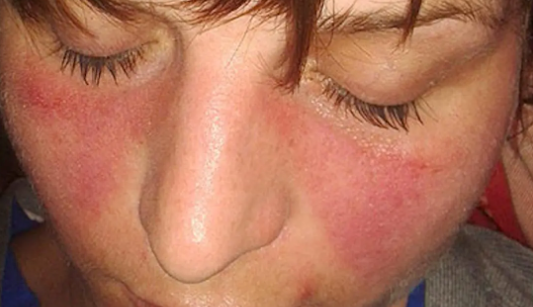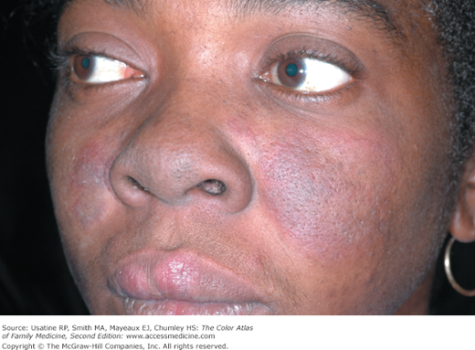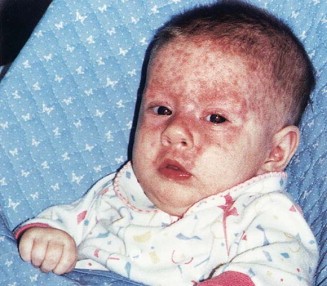Why April 1st is Important to Those with Lupus
Lupus Alert Day bring this disease into focus. About 1.5 million Americans and 5 million worldwide are affected by Lupus.

(Image credit: Doktorinternet, 2013.)
Molar rash on Lupus Patient.
As April rolls in, the perfect opportunity comes about to raise awareness about lupus and how it affects an abundance of people every day. Although it may be easy to get distracted by the laughter that April Fool’s Day brings, it is important to shine a light on this poorly understood condition.
Lupus is a disease where the immune system attacks healthy tissues in the body instead of protecting the body from infections and diseases. With this, this disease can appear in haphazard patterns. Times, where the symptoms appear or worsen, are called flare-ups. On the other hand, moments, where symptoms seem non-existent, are called moments of remission. Despite popular belief, there are no set symptoms for lupus because there are four types of this disorder, each with complex symptoms and treatment plans.
1 – Systemic Lupus Erythematosus (SLE)

When many people hear about lupus this is usually the type they think of. This is because the most common type of lupus, with approximately 70% percent of lupus cases being SLE. This condition often affects women of color, affecting black women more often than the rest of the population.
Symptoms of this disease can span from mild to severe. Some of the more minor signs of SLE can include but are not limited to:
- Fatigue
- Skin rashes
- Fevers
- Pain or swelling in the joints— also known as Arthritis
- Swelling around eyes and legs
- Abdominal pain
- Depression
- Change of color found in fingers and toes— they can become blue, purple, red, or white. This is often called Reynaud’s phenomenon.
On the other hand, some of the more extreme symptoms of systemic lupus can impact the body’s organs, such as the brain, kidneys, and heart. This includes, but is not limited to, the complications listed below:
- When pushed to the extreme, skin inflammation can go from skin redness alongside burning to form sores and ulcers. In many cases, patients with lupus will form a “butterfly rash” — a rash that spreads around noses and cheeks.
- Inflammation of the brain can cause headaches, strokes, brain fog, memory loss, and confusion. Specifically, vasculitis— the inflammation of brain blood vessels, the person with lupus can develop behavioral problems, seizures, and frequent high fevers.
- When the kidneys become inflamed it is called lupus nephritis. This condition alters the body’s ability to filter out waste from the blood. This can damage the kidneys to the point of needing a kidney transplant.
- In many cases, lupus can cause arteries to harden— this is called coronary artery disease, which can lead to a heart attack.
2 – Cutaneous Lupus Erythematosus (CLE)

CLE is the type of lupus that primarily affects the skin of the person who has it. Cutaneous Lupus is not as common as SLE, only affecting two-thirds of people with lupus. This type of lupus is commonly worsened by ultraviolet (UV) rays, which are often found in artificial and sunlight. With this, symptoms of cutaneous lupus are often shown on body parts where the sun hits the body. CLE commonly causes:
- Red rashes
- Lesions
- Raise and/or scaly marks
- Thin hair
- Change in skin’s pigmentation
Unlike the other forms of lupus, CLE usually does not hurt or itch. Doctors commonly give patients with cutaneous lupus medication to lessen the appearance of this disease, but it is not curable.
3- Drug-Induced Lupus Erythematosus (DILE)

DILE is a form of lupus that is caused by high doses of specific medicines. Common drugs that can make a user form Drug-Induced Lupus include:
- Isoniazid
- Minocycline
- Quinidine
- Hydralazine
- Methyldopa
- Chlorpromazine
The symptoms DILE produces are very similar to systemic lupus erythematosus (SLE); fatigue, joint pain, and skin rashes. Thankfully, the symptoms of lupus typically disappear after the person stops taking the medicine that started the flare-ups.
4 – Neonatal Lupus Erythematosus (NLE)

NLE is one of the rarest forms of lupus that only impacts newborn babies who have mothers that have lupus. It is caused by the antibodies of the mother transferring to the fetus during the stages of pregnancy. Similarly to DILE, these signs can go away as time passes. Neonatal Lupus has a wide range of symptoms, mostly including:
- Skin rashes
- Low blood cell count
- Liver problems
- Heart problems– if born with neonatal lupus, the baby can form a heart condition called congenital heart block. This condition makes it so that the infant’s heart starts to slow down. Unlike the other symptoms, this heart blockage does not go away in the first few months of life. If the condition gets worse the child will have to use a pacemaker to help control their heart rate.
To summarize, lupus is a very complex disease that is often under-recognized by millions of people worldwide. This is why Lupus Alert Day is so important. This day is a rare opportunity to raise awareness about lupus, educate the public about the disease, and show those with lupus support through rough times.
Sources: https://rarediseases.org/rare-diseases/neonatal-lupus/ https://www.lupus.org/resources/lupus-facts-and-statistics https://www.niams.nih.gov/health-topics/lupus#:~:text=Overview%20of%20Systemic%20Lupus%20Erythematosus%20(Lupus)&text=This%20attack%20causes%20inflammation%2C%20and,circulating%20blood%20cells%2C%20and%20brain. https://www.usinlupus.com/basics-of-lupus/types-of-lupus/ https://nyulangone.org/conditions/cutaneous-lupus/types#:~:text=Symptoms%20may%20flare%20up%20and,20%20to%2050%20years%20old. https://www.hopkinsmedicine.org/health/conditions-and-diseases/lupus/types-of-lupus https://www.lupus.org/resources/lupus-facts-and-statistics https://medlineplus.gov/ency/article/000446.htm



























